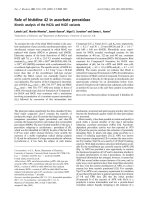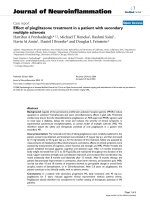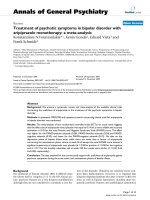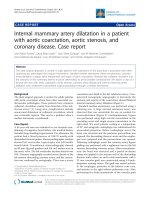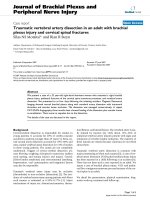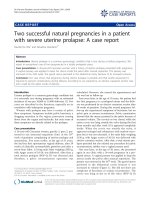Báo cáo y học: "Internal mammary artery dilatation in a patient with aortic coarctation, aortic stenosis, and coronary disease. Case report" pot
Bạn đang xem bản rút gọn của tài liệu. Xem và tải ngay bản đầy đủ của tài liệu tại đây (1.32 MB, 4 trang )
CAS E REP O R T Open Access
Internal mammary artery dilatation in a patient
with aortic coarctation, aortic stenosis, and
coronary disease. Case report
Jose Rubio Alvarez
1
, Laura Reija Lopez
1*
, Juan Sierra Quiroga
1
, Jose M Martinez Comendador
1
,
Anxo Martinez-de-Alegria
2
, Jose M Martinez Cereijo
1
and Cristian Delgado Dominguez
1
Abstract
The ideal surgical approach is unclear in adult patients with coarctation of the aorta that is associated with other
cardiovascular pathologies that require intervention. Standard median sternotomy allows simultaneous, coronary
revascularization surgery, valve replacement and repair of aortic coarctation. However the collateral circulation and
the anatomy of the mammary arteries must be determined, to avoid possible complications. We report a case of a
69 year-old man with aortic coarctation, aortic stenosis, coronary artery disease and internal mammary artery
dilatation who underwent concomitant surgical procedures through a median sternotomy.
Background
The ideal surgical approach is unclear for adults patients
with aortic coarctation whom have other associated car-
diovascular pathologies. These patients have extensive
collateral circulation, mainly from branches of the sub-
clavian artery [1]. Long-term complications include
aneurysmal dilatation of collateral circulation, which
mayeventuallyrupture.Thiscanbeaproblemwhena
median sternotomy is performed.
Case Report
A 69 year-old man was admitted to our hospital com-
plaining of congestive heart failure. His medical history
included long-standing hypertension. On admission the
patient had a blood pressure of 180/70 mmHg with
diminished femoral pulses. Electrocardiographic analysis
showed left ventricular hypertrophy and left bundle
branch block. Transthoracic echocardiography showed
an 80 mm Hg peak gradient and 0,8 cm2 surface area in
the aortic valve. The left ventricular ejection fraction was
35%. Coronary angiography revealed severe disease of the
left anterior descending coronary artery, and the coarcta-
tion was confirmed by aortography. There was a severe
coarctation just d istal to the left subclavian artery. Com-
puterized tomograp hy angiography to determine the
anatomy and severity of the coarctat ion, showed bilateral
internal mammary artery dilatation (Figure 1).
Standard median sternotomy was performed using a
vibrating saw. A large internal mammary artery was
observed that was unsuitable for use as conduit f or
revascularization (Figure 2). Cardiopulmonary bypass
was performed using high arterial cannulation in the
ascending aorta and single venous cannulation in the
right atrial. We used systemic cooling to a temperature
of 33° and antegrade cardioplegia was administered for
myocardial protection. Before cardioplegic arrest, the
heart was retracted and the posterior pericardium was
exposed, the descending thoracic aorta and the esopha-
gus were palpated and the pericardium was opened.
Following cardioplegic arrest the coronary arter y bypass
grafting was performed with a saphenous vein to the left
anterior descending coronary artery. After revasculariz a-
tion, the heart was re tracted and a partial occlusion
clamp was applied to the anterior wall of the descending
thoracic aorta where an end-to-side anastomosis with a
22 mm vascular graft was constructed using 3-0 poly-
propylene running suture. The gra ft was routed anterior
to the esophagus, posterior to the inferior vena cava,
and anterior to the right inferior pulmonary vein. After
performing the distal anas tomosis of the va scular graft
* Correspondence:
1
Department of Cardiac Surgery, Universitary Hospital Santiago de
Compostela (CHUS), SERGAS Travesia Choupana SN Santiago de Compostela,
15706 La Coruña, Spain
Full list of author information is available at the end of the article
Alvarez et al. Journal of Cardiothoracic Surgery 2011, 6:55
/>© 2011 Alvarez et al; licensee BioMed Central Ltd. T his is an Open Access a rticle distri buted un der the terms of the Creati ve Commons
Attribution License (http://c reativecommons.org/licenses/by/2.0), which permits unrestricted us e, distribution, and reproduction in
any medium, pro vided the original work is properly cited.
to the descending aorta, an aortic valve replacement was
performed using a 23 mm Sorin Bicarbon prosthesis.
The native bicuspid aortic valve was very calcified. The
aortic clamp was removed, the vascular graft was cut
obliquely and a proximal anast omosis was fashioned
end-to-side to the external side of the ascending aorta
using a partial occlusion clamp. The p roximal anasto-
mosis of the saphenous vein was performed over a dif-
ferent partial occluding clamp. The patient came off
bypass with minimal vasoconstrictor support. Cardiopul-
monary bypass and myocardial ischaemic time were
135 and 80 minutes respectively. The postoperative per-
iod was une ventful, and the patient was discharged on
his tenth postoperative day on hydrochlorothiazide, ena-
lapril and Dicumarine. Three years later, he is classified
as having NYHA class I.
A volume rendering reconstruction of the postoperative
computerized tomography scan showed a vascular graft
between the ascending aorta and descending thoracic
aorta and the aortic coarctation (Figure 3) and the bypass
to the left anterior descending coronary artery (Figure 4).
Discussion
Although coarctation of the aorta is a congenital heart
defect, it is frequently diagnosed in adulthood because
Figure 1 Computerized tomography showing bilateral internal
mammary artery dilatation.
Figure 2 Aneurysmal dilatation of the left internal mammary
artery close to the sternum.
Figure 3 Computerized tomography with volume rendering
reconstruction showing the vascular graft between the
ascending aorta and descending thoracic aorta. The aortic
coarctation is visualized.
Figure 4 C omputerized tomography with volume rendering
reconstruction showing the coronary artery bypass graft with a
saphenous vein to the left anterior descending coronary artery.
Alvarez et al. Journal of Cardiothoracic Surgery 2011, 6:55
/>Page 2 of 4
patients can remain symptom-free for many years. How-
ever, hypertension is common and more severe in older
than in younger patients, and as in this case study, older
patients with coarctation of the aorta may present with
heart failure. Collateral circulation between the part of
the aorta proximal to the coarctation and that distal to
it, it is one of the striking features of coarctation. There
is usually extensive collateral circulation in adults with
coarctation, and the source is mainly due to b ranches of
both subclavian arteries, particularly the internal thor-
acic and vertebral arteries. In these patients, long-term
complications include aortic aneurysm formation and
aneurysmal dilatation of the collateral circulation, which
may eventually rupture [1]. Overall the prevalence of
aneurysm is about 10% by the end of the second decade
of life, 20% by the end of the third decade, and probably
even higher in older patients [2]. When an adult patient
with aortic coarctation needs median sternotomy for
cardiac surgery, Laks et al [1] suggested that magnetic
resonance angiography with three dimensional compu-
terized reconstruction to assess the transverse arch, isth-
mus, and descending aorta is often useful. We think it is
necessary to define the anatomy and severity o f the
coarctation as well as the size of mammary arteries,
because these may be damaged by the saw. In the
patient presented here, we decided to use the vibrating
saw because the computerized tomography showed a
very large mammary artery near the sternum.
Approximately 25 to 50 percent of patients with
coarctation have bicuspid aortic valves, and these valves
have a tende ncy to calcify in adult life, produc ing aortic
stenosis [3]. All of these lesions impose increased after-
load on the left ventricle and, if severe and untreated,
result in hypertrophy and failure of th e left ventricle [4].
This was the case for our patient upon admission to the
hospital.
In adult patients with aortic coarctation in combina-
tion with other cardiac diseases, surgical man agement
may be complicated, and there is no consensus on the
optimal approach. The long-term outcome is known
only after surgery and although stent therapy has been
proven efficient, relatively simple and free adverse events
in the majority of case s, the equivalence of the endovas-
cular repair in the long-term has not yet been deter-
mined [5]. Some authors have suggested a single-stage
repair [6-8], while exposure of the descending aorta
through a median sternotomy and the posterior pericar-
dium was described by Vijayanagar et al [9] in a patient
with aortic coarctation associated with aortic valve
regurgitation. In that patient, the vascular graft was
placed around the left margin of the heart and was ana-
stomosed proximally to the anterior wall of the ascend-
ing aorta. Powell et al [10] described a modification of
this technique in which the graft is routed around the
right margin of the heart and anastomosed proximally
to the right lateral ascending aorta. Routing the graft
behindtheinferiorvenacava but anterior to the right
inferior pulmonary vein may protect the graft if reopera-
tion is necessary.
Conclusions
We conclude that adult patients w ith aortic coarctation
combined with other cardiac pathologies may be treated
with a singl e-stage repair. Because median sternotomy is
the best approach, we believe that to minimize morbidity,
a computerized tomography angiogram should be per-
formed prior to surgery to identify possible aneurysmal
dilatation of vessels involved in collateral circulation.
Consent
Written informed consent was obtained from the patient
for publication of this case report and accompanying
images. A copy of the written consent is available for
review by the Editor-in-Chief of this journal.
Author details
1
Department of Cardiac Surgery, Universitary Hospital Santiago de
Compostela (CHUS), SERGAS Travesia Choupana SN Santiago de Compostela,
15706 La Coruña, Spain.
2
Department of Radiology, Universitary Hospital
Santiago de Compostela (CHUS), SERGAS Travesia Choupana SN Santiago de
Compostela, 15706 La Coruña, Spain.
Authors’ contributions
LRL drafted the manuscript. JRA and JSQ conceived the study and
performed the operation. AMDA performed the radiologic study. JMMC
provided patient follow-up data. JMMC participated in the manuscript
preparation. CDD Collected references. All authors read and approved the
final manuscript.
Competing interests
The authors declare that they have no competing interests.
Received: 13 December 2010 Accepted: 17 April 2011
Published: 17 April 2011
References
1. Laks H, Marelli D, Plunkett M, Odim J, Myers J: Adult congenital heart
disease. In Cardiac Surgery in the adult. 2 edition. Edited by: Lawrence H
Cohn and L. Henry Edmunds Jr. New York, McGraw - Hill; 2003:1329-1358.
2. Schuster SR, Gross RE: Surgery for coarctation of the aorta: a review of
500 cases. J Thorac Cardiovasc Surg 1962, 43:54-70.
3. Warnes CA, Deanfield JE: Congenital heart disease in adults. In The Heart.
11 edition. Edited by: Valentin Fuster, R. Wayne Alexander and Robert A
O’Rourke. New York. McGraw - Hill; 2004:1851-1879.
4. Aboulhosn J, Child JS: Left ventricular outflow obstruction: Subaortic
stenosis, Bicuspid aortic valve, Supravalvar aortic stenosis and
Coarctation of the aorta. Circulation 2006, 114(22):2412-22.
5. Marty B: Endovascular repair for adult coarctation: stating the obvious!
Eur J Cardiothorac Surg 2010, 38(3):310.
6. Yilmaz M, Polat B, Saba D: Single-stage repair of adult aortic coarctation
and concomitant cardiovascular pathologies: a new alternative surgical
approach. Journal of Cardiothoracic Surgery 2006, 1:18.
7. Rohinton J Morris, Louis E Samuels, Stanley K Brockman: Total
Simultaneous Repair of Coarctation and Intracardiac Pathology in Adult
Patients. Ann Thorac Surg 1998, 65:1698-702.
8. Uzzi Izhar, Hartzell V Schaff, Charles J Mullany, Richard C Daly, Thomas
A Orszulak: Posterior Pericardial Approach for Ascending Aorta-to-
Alvarez et al. Journal of Cardiothoracic Surgery 2011, 6:55
/>Page 3 of 4
Descending Aorta Bypass Through a Median Sternotomy. Ann Thorac
Surg 2000, 70:31-7.
9. Vijayanagar R, Natarajan P, Eckstein PF, Bognolo DA, Toole JC: Aortic
valvular insufficiency and postductal aortic coarctation in the adult.
Combined surgical management through median sternotomy: a new
surgical approach. J Thorac Cardiovasc Surg 1980, 79:266-8.
10. Powell WR, Adams PR, Cooley DA: Repair of coarctation of aorta with
intracardiac repair. Tex Heart Inst J 1983, 10:409-13.
doi:10.1186/1749-8090-6-55
Cite this article as: Alvarez et al.: Internal mammary artery dilatation in
a patient with aortic coarctation, aortic stenosis, and coronary disease.
Case report. Journal of Cardiothoracic Surgery 2011 6:55.
Submit your next manuscript to BioMed Central
and take full advantage of:
• Convenient online submission
• Thorough peer review
• No space constraints or color figure charges
• Immediate publication on acceptance
• Inclusion in PubMed, CAS, Scopus and Google Scholar
• Research which is freely available for redistribution
Submit your manuscript at
www.biomedcentral.com/submit
Alvarez et al. Journal of Cardiothoracic Surgery 2011, 6:55
/>Page 4 of 4
